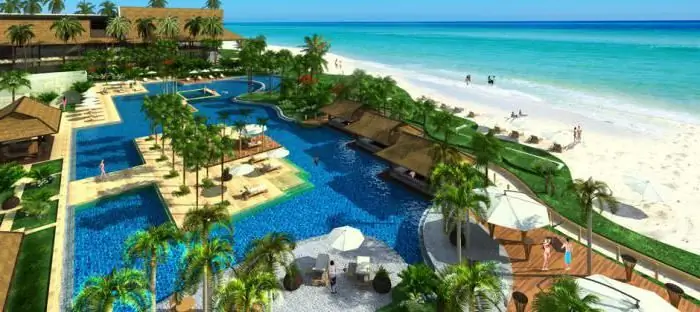- Author Harold Hamphrey [email protected].
- Public 2023-12-17 10:06.
- Last modified 2025-01-24 11:10.
This article will focus on the sights of Manila - the capital of the Philippines, perhaps the most contrasting Asian city, in which luxury and we alth closely coexist with poverty and wretchedness. Here you can see how strikingly large skyscrapers with their huge "paws" step on dilapidated concrete boxes. A lot of people live in Manila - the population density literally rolls over. But there are also many attractions in the Philippine capital.

Intramuros Fortress
It is recommended to start sightseeing in Manila from Intramuros. The name translates from Spanish as "within the walls". This is a fortress that appeared in the second half of the 16th century in order to protect the Spanish colonists from Chinese pirates. The complex grew over two centuries, but was badly damaged during the Second World War. But here is the charmantiquity. There are many different buildings inside the fortress: houses, museums, hotels, restaurants and so on. On one side, Fort Santiago adjoins Intramuros.
Bahai Qinoy Historical Museum
It is located in Intramuros and is intended mainly to tell about the relationship between the Chinese and Filipino minorities, to provide tourists with information about the life of the local people, about their culture and way of life. Here is one huge collection, which is divided into several topics. The expositions tell about the first contacts between Chinese settlers and Filipinos, about life during the period of the Spanish colonial regime. There are also many drawings, photos, furniture, ceramics, art and rare sea shells.

Jose Rizal Park
A dark place if you know its history. Once this area was completely cleared of vegetation in order to protect the southern approach to Intramuros. In the 1900s, executions of objectionable citizens were carried out here. How many people lost their lives - only God knows. Among the unfortunates was José Rizal (or Rizal) - the national hero of the Philippines, an outstanding poet and writer. Therefore, when a park appeared here with a botanical pavilion, a museum, monuments and a mausoleum with the ashes of a hero, he was given the name Rizala.
Malacañang Palace
When visiting the sights of Manila, it is recommended not to miss this charming mansion, built in 1750 especially for Don Luis Roja, a Spanish aristocrat. The palace looks quite luxurious. It's donein the Spanish style, which is reflected both in the interior and exterior of the building. And the interior decoration still represents certain events in the life of the state. For example, the Main Staircase is hung with portraits of conquistadors. There are also several halls here: Heroes, Receptions and Ceremonial.

Aristocratic mansion Casa Manila
Casa Manila today is a museum. But initially the building was built for an aristocratic family. The following can be said about this attraction of Manila: the house is perfectly preserved, although it was built back in the 19th century. Inside and out, if you look closely, you can see many interesting details. For example, carved balconies, inscriptions, reliefs. And the interior of the building is completely preserved, starting with the furnishings and ending with the design style.
Manila Cathedral
The Basilica of the Immaculate Conception is an active Catholic church and the seat of the Philippine Archbishop. Modern building - 6 in a row. It was built only in 1958. And the first building appeared in 1581.
Inside the Cathedral there are burials of national leaders. The Basilica of the Immaculate Conception is made in the Romanesque style: dark brick walls contrasting with white statues of saints. The cathedral is crowned with a bell tower and a bronze dome. Located in the Intramuros area.

Tahanang Filipino, or Coconut Palace
Was built on the initiative of the wife of a politician of the Philippines especially for the Pope in 1981year. Then the construction of such a building cost the treasury 10 million dollars. But the Pope considered this house "indecent", and refused to stay in it. Why Coconut? Sources about this Manila attraction claim that it was built from palm wood and coconut shells. The palace is located in the cultural center of Malate.
Cultural Center of the Philippines
This place is a large concert and exhibition hall, which was created specifically to preserve, develop and popularize national art. There are several libraries, theater stages and galleries, there is even a museum.

Historic Binondo
Manila (Philippines) has a Chinese historical quarter on its territory, where you can feel the atmosphere 100%. Chinese lanterns, bright signs and street vendors selling exotic fruits form a unique flavor here. Binondo has Buddhist temples and a Catholic church, business centers and financial institutions. In general, life is in full swing, as in the rest of Manila.
City Observatory
The old observatory in Manila was built in 1865 by the Jesuits to predict typhoons. It is located on the campus of Quezon City University. Once upon a time, a branch was established at an altitude of 5000 feet above sea level, but the Second World War interrupted its work. All tools were destroyed during the Battle of Manila.
Reviews of Manila
The city of Manila (Philippines) surprises tourists with itsextraordinary. It's not just contrasts. Here, guests of the Philippine capital have the opportunity to encounter interesting moments. For example, on one of the sites, a girl described how warmly the locals treat Russia. They don't just know that such a country exists. They know where she is, who is her supreme commander, they even ask questions about the collapse of the USSR.
In general, if there is an opportunity to visit Manila, you should not refuse such a chance. However, it should be said that many tourists were not enthusiastic about the sights. Manila Bay and the beauty of nature gave much more pleasant impressions.






